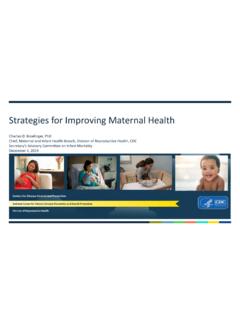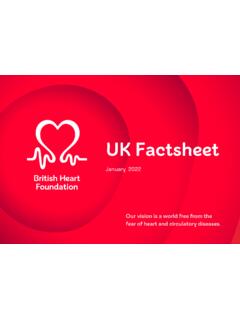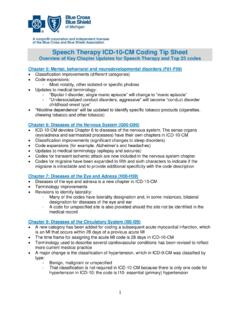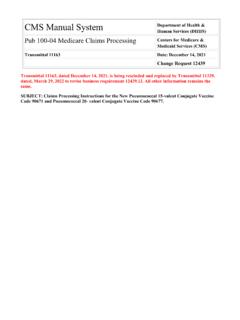Transcription of The ABCs of the Annual Wellness Visit (AWV)
1 1 DEPARTMENT OF HEALTH AND HUMAN SERVICESC enters for Medicare & Medicaid ServicesThe ABCs of the Annual Wellness Visit (AWV)ICN 905706 January 2015 Please note: The information in this publication applies only to the Medicare Fee-For-Service Program (also known as Original Medicare).Medicare covers an Annual Wellness Visit (AWV) providing Personalized Prevention Plan Services (PPPS) for beneficiaries who: Are not within the first 12 months of their first Medicare Part B coverage period; and Have not received an Initial Preventive Physical Examination (IPPE) or AWV within the past 12 document is divided into two sections: the first explains the elements of a beneficiary s initial AWV; the second explains the elements of all subsequent AWVs. You must provide all elements of the AWV prior to submitting a claim for the : The AWV is a separate service from the IPPE. For more information about the IPPE, refer to The ABCs of the Initial Preventive Physical Examination (IPPE) at on the Centers for Medicare & Medicaid Services (CMS) Risk Assessment (HRA)The AWV includes a Health Risk Assessment (HRA).
2 While you can find a brief summary of the minimum elements in the HRA below, the Centers for disease Control and Prevention s (CDC) A Framework for Patient-Centered Health Risk Assessments: Providing Health Promotion and disease Prevention Services to Medicare Beneficiaries includes sections about: The history of HRAs; Definition of the HRA framework and rationale for its use; HRA use and follow-up interventions that evidence suggests can influence health behaviors; and A suggested set of HRA more information about HRAs, including a sample HRA, refer to http://www. on the CDC only copyright 2014 American Medical Association. All rights reserved. CPT is a registered trademark of the American Medical Association. Applicable FARS\DFARS Restrictions Apply to Government Use. Fee schedules, relative value units, conversion factors and/or related components are not assigned by the AMA, are not part of CPT, and the AMA is not recommending their use.
3 The AMA does not directly or indirectly practice medicine or dispense medical services. The AMA assumes no liability for data contained or not contained AWV Components: Applies for the First Time a Beneficiary Receives an AWVA cquire Beneficiary InformationAcquire Beneficiary InformationRequired Elements Administer HRA Collects self-reported information from the beneficiary; You or the beneficiary can complete the HRA before or during the AWV encounter; Accounts for the communication needs of underserved populations, persons with limited English proficiency, and persons with health literacy needs and is appropriately tailored to their needs; Takes no more than 20 minutes to complete; and At a minimum, addresses the following topics: Demographic data; Self-assessment of health status; Psychosocial risks; Behavioral risks; Activities of Daily Living (ADLs), including, but not limited to: dressing, bathing, and walking; and Instrumental ADLs, including, but not limited to: shopping, housekeeping, managing own medications, and handling finances.
4 Establish a list of current providers and suppliersInclude current providers and suppliers regularly involved in providing medical care to the beneficiary. Establish the beneficiary s medical/family historyAt a minimum, collect and document the following: Medical events in the beneficiary s parents, siblings, and children, including diseases that may be hereditary or place the beneficiary at increased risk; Past medical and surgical history, including experiences with illnesses, hospital stays, operations, allergies, injuries, and treatments; and Use of, or exposure to, medications and supplements, including calcium and vitamins. Review the beneficiary s potential risk factors for depression, including current or past experiences with depression or other mood disordersUse any appropriate screening instrument for beneficiaries without a current diagnosis of depression, which you may select from various available standardized screening tests designed for this purpose and recognized by national professional medical organizations.
5 Review the beneficiary s functional ability and level of safetyUse direct observation of the beneficiary, or select appropriate screening questions or a screening questionnaire, from various available screening questions or standardized questionnaires recognized by national professional medical organizations to assess, at a minimum, the following topics: Ability to successfully perform ADLs; Fall risk; Hearing impairment; and Home AssessmentBegin AssessmentRequired Elements AssessObtain the following measurements: Height, weight, body mass index (or waist circumference, if appropriate), and blood pressure; and Other routine measurements as deemed appropriate based on medical and family history. Detect any cognitive impairment the beneficiary may haveAssess the beneficiary s cognitive function by direct observation, with due consideration of information obtained via beneficiary reports and concerns raised by family members, friends, caretakers, or BeneficiaryCounsel BeneficiaryRequired Elements Establish a written screening schedule for the beneficiary, such as a checklist for the next 5 to 10 years, as appropriateBase written screening schedule on: Age-appropriate preventive services Medicare covers; Recommendations from the United States Preventive Services Task Force (USPSTF) and the Advisory Committee on Immunization Practices (ACIP); and The beneficiary s HRA, health status, and screening history.
6 Establish a list of risk factors and conditions for which the primary, secondary, or tertiary interventions are recommended or underway for the beneficiaryInclude the following: Any mental health conditions or any risk factors or conditions identified through an IPPE; and A list of treatment options and their associated risks and benefits. Furnish personalized health advice to the beneficiary and a referral, as appropriate, to health education or preventive counseling services or programsIncludes referrals to programs aimed at: Community-based lifestyle interventions to reduce health risks and promote self-management and Wellness ; Fall prevention; Nutrition; Physical activity; Tobacco-use cessation; and Weight AWV Components: Applies for all Subsequent AWVs After a Beneficiary s First AWVA cquire Update of Beneficiary HistoryAcquire Update of Beneficiary InformationRequired Elements Update HRA Collects self-reported information from the beneficiary; You or the beneficiary can complete the update of HRA before or during the AWV encounter; Takes no more than 20 minutes to complete; and At a minimum, addresses the following topics: Demographic data; Self-assessment of health status; Psychosocial risks; Behavioral risks; ADLs, including, but not limited to: dressing, bathing, and walking.
7 And Instrumental ADLs, including, but not limited to: shopping, housekeeping, managing own medications, and handling finances. Update the list of current providers and suppliersInclude current providers and suppliers regularly involved in providing medical care to the beneficiary. Update the beneficiary s medical/family historyAt a minimum, update and document the following: Medical events in the beneficiary s parents, siblings, and children, including diseases that may be hereditary or place the beneficiary at increased risk; Past medical and surgical history, including experiences with illnesses, hospital stays, operations, allergies, injuries, and treatments; and Use of, or exposure to, medications and supplements, including calcium and AssessmentBegin AssessmentRequired Elements AssessObtain the following measurements: Weight (or waist circumference, if appropriate) and blood pressure; and Other routine measurements as deemed appropriate based on medical and family history.
8 Detect any cognitive impairment that the beneficiary may haveAssess the beneficiary s cognitive function by direct observation, with due consideration of information obtained via beneficiary reports and concerns raised by family members, friends, caretakers, or BeneficiaryCounsel BeneficiaryRequired Elements Update the written screening schedule for the beneficiaryBase written screening schedule on: Age-appropriate preventive services Medicare covers; Recommendations from the USPSTF and the ACIP; and The beneficiary s health status and screening history. Update the list of risk factors and conditions for which primary, secondary, or tertiary interventions are recommended or underway for the beneficiaryInclude any such risk factors or conditions identified. Furnish personalized health advice to the beneficiary and a referral, as appropriate, to health education or preventive counseling services or programsIncludes referrals to programs aimed at: Community-based lifestyle interventions to reduce health risks and promote self-management and Wellness ; Fall prevention; Nutrition; Physical activity; Tobacco-use cessation.
9 And Weight Medicare Part B Preventive Services Alcohol Misuse Screening and Counseling Bone Mass Measurements cardiovascular disease Screening Tests Colorectal Cancer Screening Counseling to Prevent Tobacco Use (for Asymptomatic Beneficiaries) Depression Screening Diabetes Screening Diabetes Self-Management Training (DSMT) Glaucoma Screening Hepatitis C Virus (HCV) Screening Human Immunodeficiency Virus (HIV) Screening Influenza, Pneumococcal, and Hepatitis B Vaccinations and their Administration IPPE Intensive Behavioral Therapy (IBT) for cardiovascular disease (CVD), also known as a CVD risk reduction Visit IBT for Obesity Medical Nutrition Therapy (MNT) Prostate Cancer Screening Screening for Sexually Transmitted Infections (STIs) Screening And High Intensity Behavioral Counseling (HIBC) to Prevent STIs Screening Mammography Screening Pap Tests Screening Pelvic Examination (includes a clinical breast examination) Ultrasound Screening for Abdominal Aortic Aneurysm (AAA)For additional information on Medicare preventive services, Visit Medicare-Learning-Network-MLN/MLNP roducts/Preventive on the CMS website, or scan the Quick Response (QR) code on the Cancer Screening Counseling and Annual Screening for Lung Cancer with Low Dose Computed Tomography Effective February 5, 2015, Medicare began covering lung cancer screening counseling and a shared decision making Visit , and for appropriate beneficiaries, Annual screening for lung cancer with low dose computed tomography (LDCT).
10 For more information, Visit medicare-coverage-database/ on the CMS , Diagnosis, and BillingCodingUse the following Healthcare common Procedure Coding System (HCPCS) codes when filing claims for HCPCS Codes and DescriptorsAWV HCPCS CodesBilling code DescriptorsG0438 Annual Wellness Visit ; includes a personalized prevention plan of service (PPPS), initial visitG0439 Annual Wellness Visit , includes a personalized prevention plan of service (PPPS), subsequent visitDiagnosisSince CMS does not require a specific diagnosis code for the AWV, you may choose any appropriate diagnosis code . You must report a diagnosis Part B covers AWV if performed by a: Physician (a doctor of medicine or osteopathy); Qualified non-physician practitioner (a physician assistant, nurse practitioner, or certified clinical nurse specialist); or Medical professional (including a health educator, registered dietitian, nutrition professional, or other licensed practitioner)or a team of such medical professionals who are working under the direct supervision of a physician (doctor of medicine or osteopathy).





